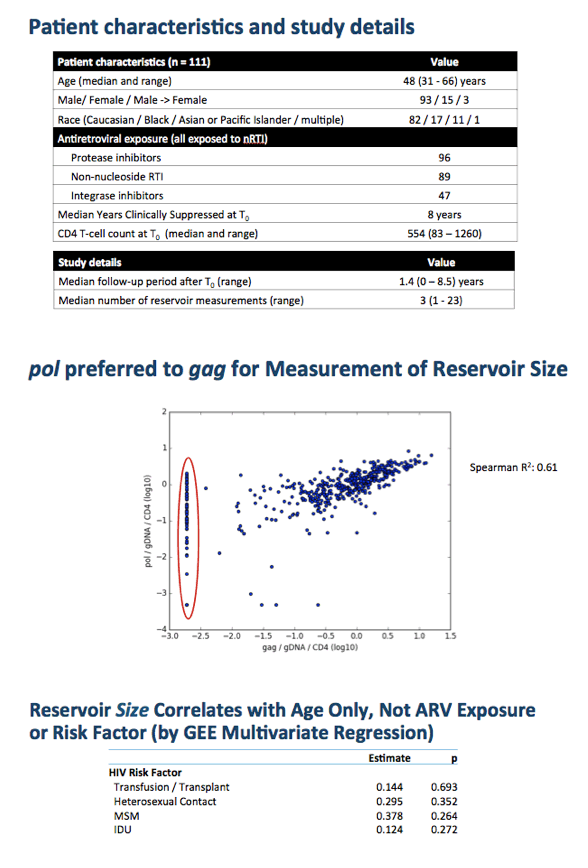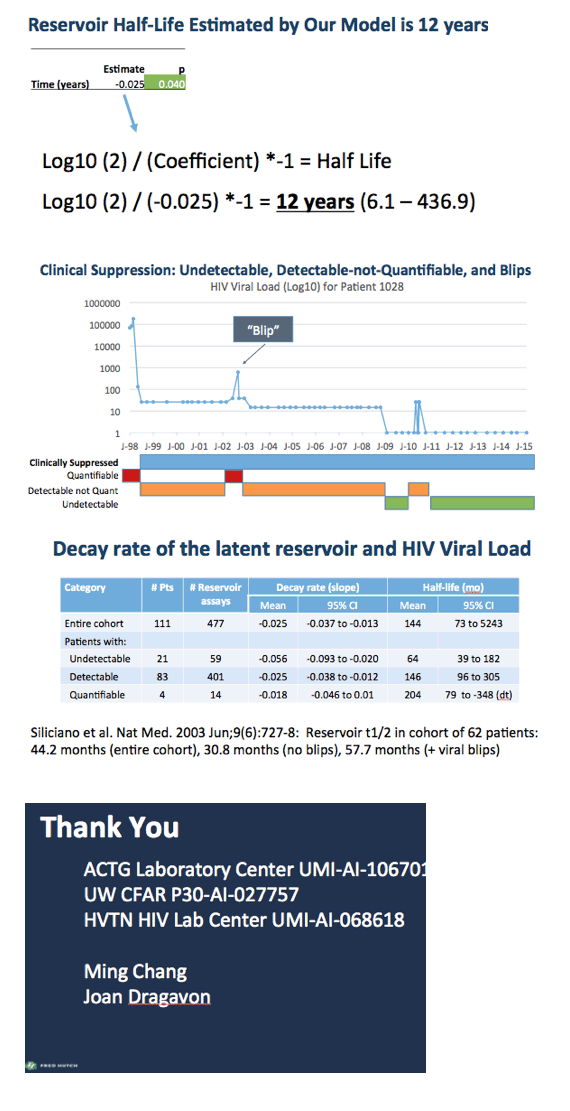 |
 |
 |
| |
HIV Reservoir Half-Life 12 Years in 111-Person,
477-Sample Analysis [slow decay] -
|
| |
| |
The HIV Reservoir in Long-Term Clinically Suppressed Patients: Size Depends on Age and Decay on Peak Viremia
IDWeek 2016, October 26-30, 2016, New Orleans
Mark Mascolini
In 111 antiretroviral-treated people with long-term viral suppression, HIV reservoir half-life averaged 12 years (144 months) [1], much longer than in previous studies. Reservoir half-life averaged less than half that (64 months) in a subset of people with never-detectable virus throughout follow-up in this analysis at the University of Washington, Seattle, and the Fred Hutchinson Cancer Research Center.
Size of the HIV reservoir--proviral HIV DNA integrated into the DNA of resting T cells--is a critical factor in determining whether HIV eradication strategies will work and perhaps how long an eradication strategy must last. Research so far, the Seattle team observed, indicates that reservoir size varies greatly from person to person and decays slowly in people taking an antiretroviral regimen that makes HIV RNA undetectable in plasma. Prior work reviewed by the investigators reported reservoir half-lives averaging 70 months in people with acute HIV infection, 96 months in chronic infection and from 6.3 months to 44 months in people with suppressed viremia.
The new analysis involved 111 people with undetectable HIV RNA in plasma for at least 5 years. The investigators measured their HIV reservoir 477 times with qPCR for the pol or gag gene. They preferred pol to gag for measuring reservoir size because inaccuracies can result from gag mutations. The researchers found little within-person variation in assay results.
The study population had a median age of 48 years (range 31 to 66) and included 93 men (84%), 15 women (14%), and 3 male-to-female transgenders (3%). Racial proportions were 74% white, 15% black, and 11% Asian or mixed. Median duration of viral suppression measured 8 years and median CD4 count 554 (range 83 to 1260). Median study follow-up stood at 1.4 years and median number of reservoir measurements 3.
In the whole study group the investigators estimated reservoir half-life at an average 144 months (12 years, 95% confidence interval [CI] 73 to 5243 months). They divided participants into those with always-undetectable HIV RNA (n = 21), detectable but not quantifiable virus (n = 83), and occasionally quantifiable virus (blips) (n = 4).
Reservoir half-lives averaged 64 months (95% CI 39 to 182) in those with always-undetectable virus, 146 months (95% CI 96 to 305) in those with detectable but not quantifiable virus, and 204 months (95% CI 79 to 348 months) in those with sometimes quantifiable blips. In comparison, reservoir half-lives in a 62-person study by Robert Siliciano's group were 44.2 months for the entire group, 57.7 months for people with blips, and 30.8 months for people with no blips [2].
In the Seattle study, the viral decay slope averaged -0.025 in the whole group, but was much faster (-0.056) in the always-undetectable group. In contrast, decay slope averaged -0.025 in the detectable/not quantifiable group and -0.018 in the blip group.
Reservoir size correlated with older age but not with antiretroviral regimen, gender, race, or HIV transmission mode.
The longer reservoir half-lives in this study than in earlier research--even in people with always undetectable virus--suggest the latent reservoir may be more intransigent than previously assumed. The Seattle researchers believe their results merit attention because of (1) the large size of the cohort followed over a median of 17 months, (2) greater accuracy in amplifying the pol region rather than gag, and (3) little within-person variation in assay results. But they added that they measured total cellular DNA with qPCR, which detects mostly defective proviral DNA rather than replication-competent provirus.
Reference
1. Golob J, Stern J, Holte S, et al. HIV reservoir size and decay in 114 individuals with suppressed plasma virus for at least seven years: correlation with age and not ARV regimen. IDWeek 2016, October 26-30, 2016, New Orleans. Abstract 953.
2. Siliciano JD, Kajdas J, Finzi D, et al. Long-term follow-up studies confirm the stability of the latent reservoir for HIV-1 in resting CD4+ T cells. Nat Med. 2003;9:727-728.
---------------
The HIV Reservoir in Long-Term Clinically Suppressed Patients: Size Depends on Age and Decay on Peak Viremia
Reported by Jules Levin
IDWeek Oct 26-30 2016 New Orleans
Jonathan Golob, MD / PhD1,2, Joshua Stern, MS3, Sarah Holte, PhD4, Mari Kitahata, MD, MPH5, Heidi Crane, MD, MPH1, Robert Coombs, MD / PhD6, Erin Goecker, BS6, Anne Woolfrey, MD7 and Robert Harrington, MD1, (1)Medicine: Aid, University of Washington, Seattle, WA, (2)Vaccine and Infectious Disease, Fred Hutchinson Cancer Research Center, Seattle, WA, (3)Global Health, University of Washington, Seattle, WA, (4)Public Health Sciences, Fred Hutchinson Cancer Research Center, Seattle, WA, (5)Center for AIDS Research, University of Washington, Seattle, WA, (6)Laboratory Medicine, University of Washington, Seattle, WA, (7)Medicine: Oncology, University of Washington, Seattle, WA
Program abstract:
Background:The HIV latent reservoir is the sum of the replication-competent proviral copies in an infected person and is directly correlated to the PBMC proviral copy number as determined by PCR amplification. In suppressed individuals, the reservoir size over time is determined by the size at baseline (when first suppressed) and the proliferative and decay rates of cells that comprise the reservoir.
Methods:In this study we examined 114 HIV-infected persons on suppressive ART for a minimum of 7 years who had donated serial PBMC specimens to the UW CFAR Specimen Repository. We determined the HIV proviral copy number per million PBMCs, corrected for CD4 count, in 477 specimens from these patients collected after a minimum of 7 years and up to 15.5 years of viral suppression. Generalized estimating equations (GEE) with an exchangeable working correlation structure and robust standard errors were used to estimate associations between reservoir size and time, age at entry, ARV regimen and risk factors for acquisition of HIV.
Results: We found that 1) the reservoir size as determined by amplification of gag and pol was similar in all but a few patients in which gag result approached zero, likely representing gag mutations that impaired amplification; 2) the inter-subject baseline reservoir size varied widely between 0.01 and 4.8 pol copies per mcg gDNA and per CD4 cell; 3) the reservoir size was lower for those at younger ages when suppression was achieved; 4) the reservoir size was not affected by the specific ARV regimen needed to achieve and maintain suppression; and 5) the reservoir size declined with time (half-life was estimated at 12 years, 95% confidence interval of 6.2-240 years).
Conclusion: This is the largest, longitudinal HIV reservoir study to date and confirms previous investigations demonstrating a slow decay rate and no differential effect by antiretroviral regimen, but suggests an association between age at viral suppression and reservoir size.




|
| |
|
 |
 |
|
|